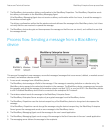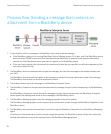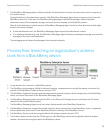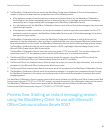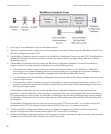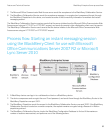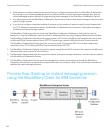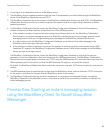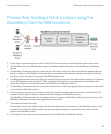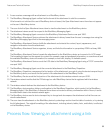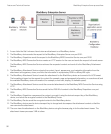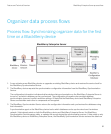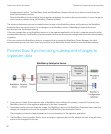1. A user logs in to a collaboration client on a BlackBerry device.
2. The BlackBerry device compresses and encrypts the user ID and password, and sends them through the BlackBerry
Router to the BlackBerry Dispatcher over port 3101.
3. The BlackBerry Dispatcher sends the request to the BlackBerry Collaboration Service over port 3200. If the BlackBerry
Collaboration Service is located on a remote computer, the request remains encrypted using a Research In Motion
proprietary protocol.
4. The BlackBerry Collaboration Service checks the BlackBerry Configuration Database to find out if the maximum
number of sessions has been reached, and performs one of the following actions:
• If the maximum number of sessions has been reached and a timeout limit is set, the BlackBerry Collaboration
Service
logs out any instant messaging sessions on BlackBerry devices that are out of coverage, and any instant
messaging sessions that are no longer sending status messages to the
BlackBerry Collaboration Service.
• If no idle sessions exist, the BlackBerry Configuration Database sends a Server Busy status message to the
BlackBerry device and rejects the login request.
• If the maximum number of sessions is not set and the number of sessions equals the total number that the IBM
Sametime API supports, the BlackBerry Configuration Database sends a Failed status message to the BlackBerry
device and rejects the login request.
The BlackBerry Collaboration Service checks the BlackBerry Configuration Database to verify that the user has
permission to use the collaboration client, and connects to the IBM Sametime server. The BlackBerry Collaboration
Service
starts an encrypted proxy connection over TCP/IP using the IBM Sametime API, reformats the request from the
RIM proprietary protocol format into one that the IBM Sametime API supports, and sends the request.
By default, the BlackBerry Collaboration Service starts the connection over port 1533 unless you specify a custom port
number.
5. The IBM Sametime server accepts the login request from the BlackBerry device, starts a dedicated TCP/IP connection
for the session, and listens for requests from the
BlackBerry device for the session.
6. The BlackBerry Collaboration Service sends the acceptance, in encrypted and compressed format, through the
BlackBerry Dispatcher to the BlackBerry device, and creates a cache of the connectivity information to maintain the
instant messaging session.
Process flow: Starting an instant messaging session
using the BlackBerry Client for Novell GroupWise
Messenger
Feature and Technical Overview BlackBerry Enterprise Server process flows
85



